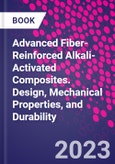Advanced Fiber-Reinforced Alkali-Activated Composites: Design, Mechanical Properties, and Durability covers various fiber types and their usage as a sustainable material as well as their influence on mechanical properties and behavior, including compressive strength, tensile strength, flexural strength, and impact and bond resistance. Their durability in different environments (seawater, magnesium sulphate, sulphuric acid, elevated temperature, corrosive) is also discussed. The book also outlines a variety of mix design and curing regimes for alkali-activated composites. The additive manufacturing of these composites is also covered.
Different types of fiber-reinforced alkali-activated composites discussed include steel fiber-reinforced, carbon fiber-reinforced, natural fiber-reinforced, synthetic fiber-reinforced, and others.
Please Note: This is an On Demand product, delivery may take up to 11 working days after payment has been received.
Table of Contents
1 Introduction to fiber-reinforced alkali-activated composites
2 Fiber classifications and physical and mechanical properties of different fibers used in alkali-activated composites
3 Mix design for the high performance of fiber-reinforced alkali-activated composites
4 Rheology of fiber reinforced alkali-activated composites
5 3D printing of the fiber-reinforced alkali-activated composites
6 Mixing methods and fresh state properties of fiber-reinforced one-part alkali-activated composites
7 The effect of curing regimes on fiber-reinforced alkali-activated composites
8 Mechanical performance of steel fiber-reinforced alkali-activated composites
9 Mechanical performance of carbon fiber-reinforced alkali-activated composites
10 Mechanical performance of inorganic polymer fiber-reinforced alkali-activated composites
11 Mechanical performance of natural fiber-reinforced alkali-activated composites
12 Mechanical performance of synthetic fiber-reinforced alkali-activated composites
13 Durability of steel fiber-reinforced alkali-activated composites
14 Experimental study on strength and durability properties of alkali-activated fibrous concrete comprising glass fiber
15 Durability of inorganic fiber-reinforced alkali-activated composites
16 Durability of natural fiber-reinforced alkali-activated composites
17 Durability of synthetic fiber-reinforced alkali-activated composites
18 Durability of hybrid fiber-reinforced alkali-activated composites








